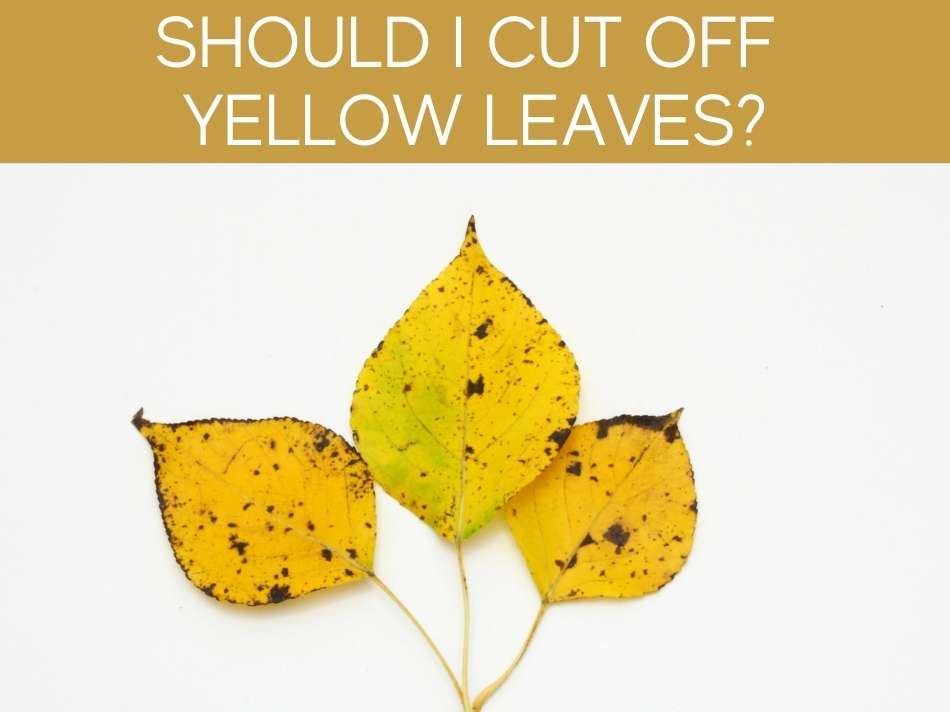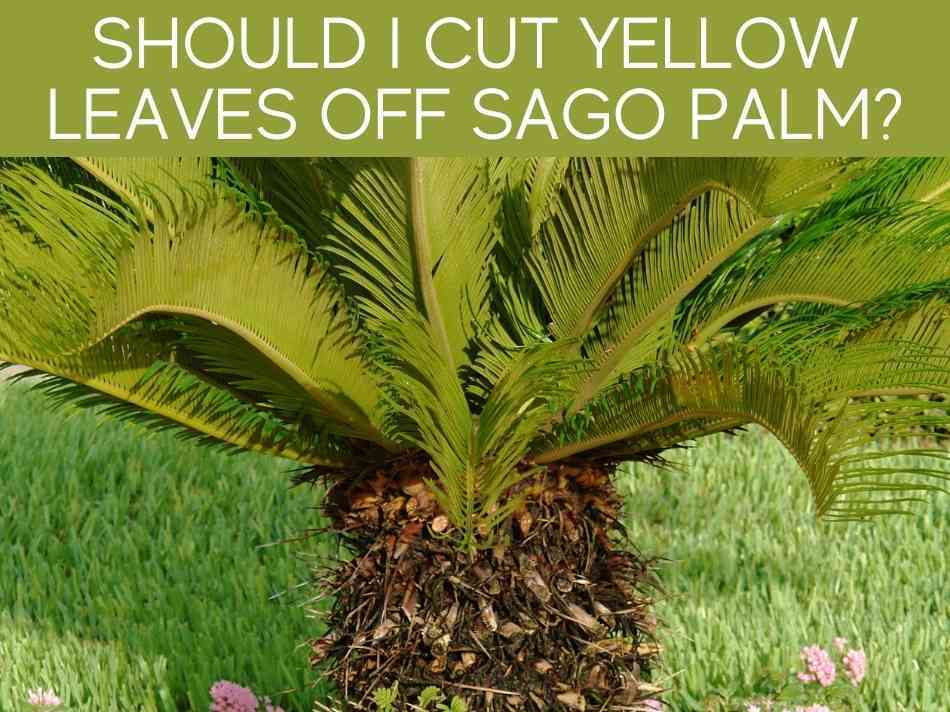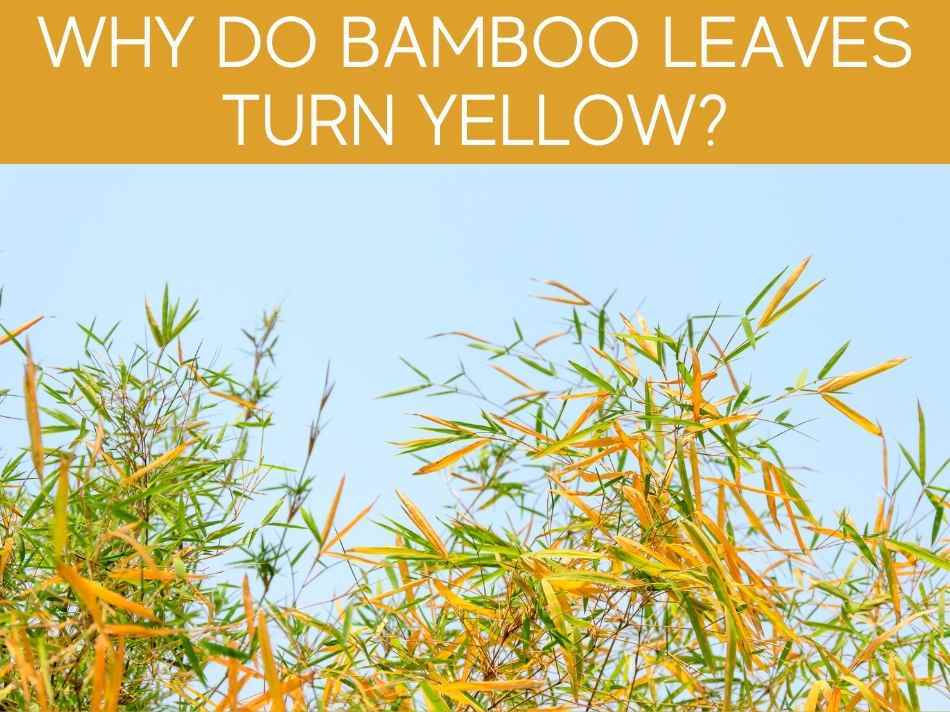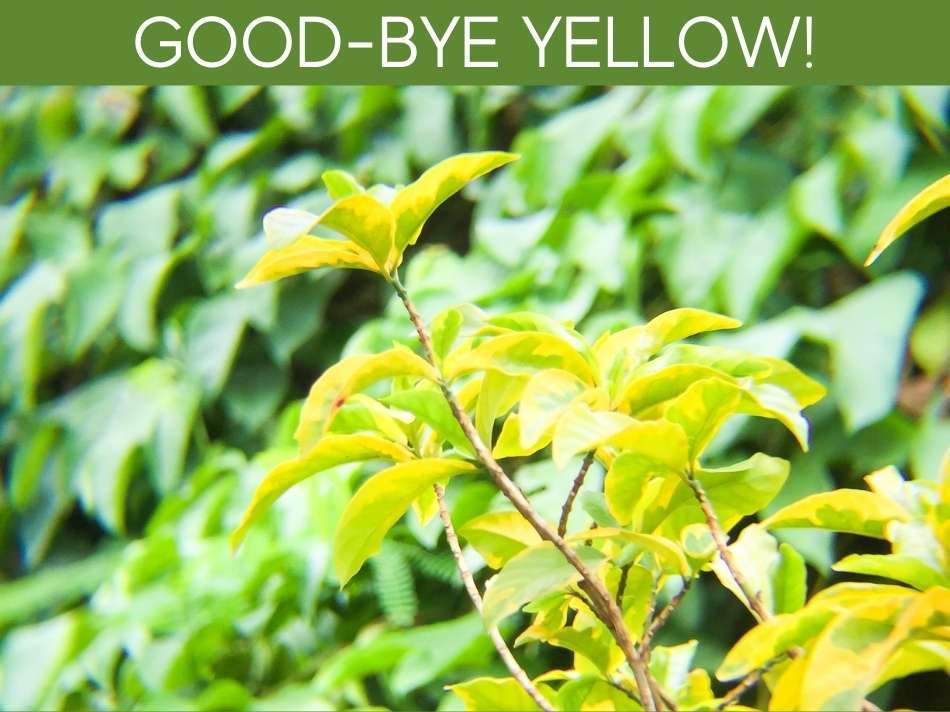When your green plants turn yellow, the question arises: should I take these yellow leaves off my plant? In gardening, green is usually what we’re going for, and when green leaves turn yellow, gardeners want to know what to do.
It’s generally OK to remove yellow leaves off plants, since yellowing leaves can be prone to scorching & disease. However, it’s important to understand that yellow leaves are most commonly caused by poor drainage, damaged roots, high soil pH, or nutrient deficiencies–especially nitrogen or iron.
Knowing whether or not you can pick off yellowed leaves depends on what you are growing. If there are many yellowed leaves, it’s important to discover the underlying problem and fix it, or else pretty soon you’ll be pruning away your whole plant!
Should I pick off yellow leaves?

Generally, it’s safe to remove a few yellowed leaves from your plant.
But there are some caveats (see below).
Removing yellow leaves keeps your plant looking healthy and your garden looking green.
Removing yellow leaves can also reduce the risk of disease, which can develop more quickly on decaying leaves rather than healthy ones.
Removing yellow leaves can also reduce the risk of pests, which can gravitate to weaker plants.
And, quite frankly, picking off yellow leaves usually just looks better.
If there are many yellow leaves on your plant, you should figure out what is causing the leaves to yellow.
Top reasons leaves turn yellow
Plant leaves turning yellow is called chlorosis, and this can happen for a variety of reasons, including:
- Lack of sunlight
- Overwatering
- Underwatering
- Poor drainage
- Damaged roots
- High soil pH
- Compacted roots
- Nutrient deficiencies
- Normal plant aging
- Viral infection
A good place to start is to revisit your specific plants’ needs.
Usually, the seed packet itself, or the tag on a purchased plant, will give these basic instructions.
Does your plant need full sun?
Does your plant thrive in a drier climate, and perhaps you are overwatering it?
Does your plant need plenty of water, and perhaps you need to water it more?
Is your plant a “heavy feeder,” requiring lots of nutrients in a fertile soil?
Does your plant prefer temperatures hotter or cooler than its current surroundings?
Read over the needs of your specific plant, and make sure you’re accommodating its preferences.
Yellow leaves due to nutrient deficiency
Many times, yellowing leaves are a result of a nutrient deficiency.
Other issues listed above, such as damaged roots or high soil pH, are part of the problem because they are inhibiting the plant’s ability to take up its required nutrients.
Different nutrient deficiencies present different symptoms in a plant.
For example, a nitrogen deficiency can cause a yellowing of older leaves, beginning at the base of the plant.
A sulphur deficiency can cause new leaves to turn yellow.
A lack of potassium, magnesium or manganese can cause yellowing on certain parts of a leaf, in splotches, on the tips, or along the veins.
To adjust these nutrient problems, you need to make sure that your plants are growing in well-drained soil that has all the nutrients it needs.
You may need to move your plant to a larger pot or ensure that there is proper drainage.
Drainage holes in a container, and a layer of gravel, are a good way to make sure that water drains properly.
You may need to test your soil’s pH level to ensure that it is not too acidic or too alkaline.
You might need to add fresh soil, or fresh fertilizer, to your garden.
Yellow leaves caused by old age
In some cases, leaves yellow on plants simply because of age.
(Age — it gets us all, doesn’t it?)
Leaves yellowing due to aging typically begins at the base of the plant.
In the case of aging, there’s really nothing you can do; it’s all just part of the plant’s normal life cycle.
Time marches on.
While you can’t set back the clock, you can trim your plant back to keep it bushy and full.
Should you pull yellow leaves off plants?

At some point, every gardener encounters yellowing leaves.
The question is, should you remove these yellow leaves from plants?
The answer, of course, depends on what exactly you’re growing, but in general it’s safe to pluck off a few yellowed leaves from your plant.
In fact, removing yellow leaves can actually help keep your plant healthy by avoiding diseases and pests.
If your plant has many yellow leaves, it’s important to determine what is causing the problem.
If you don’t fix the underlying problem, you will keep having more leaves turn yellow.
Plant leaves turning yellow is called chlorosis, and this can happen for a variety of reasons, including:
- Lack of sunlight
- Overwatering
- Underwatering
- Poor drainage
- Damaged roots
- High soil pH
- Compacted roots
- Nutrient deficiencies
- Normal plant aging
- Viral infection
A good starting point is to look at the requirements for your specific plant — its preferred temperature, amount of water, nutrient needs and required sunlight.
Go through this list of your plant’s preferences, and make sure you’re meeting its needs as best you can.
Sometimes, plant leaves turn yellow simply due to aging.
In this case, you’re pretty powerless to do anything about it.
If aging is the culprit, your plant’s leaves are probably yellowing from the bottom of the plant up.
When you remove the leaves, your plant might look a little “leggy.”
To avoid this look, and to keep things looking bushy and full, you can trim back the main stem of the plant as well.
Should I cut off yellow leaves?

If your plant just has a few yellow leaves, there’s probably not a major underlying problem and it’s likely safe to remove the yellow leaves.
If there are many yellow leaves, this discoloration is called chlorosis and could be caused by one of the following issues:
- Lack of sunlight
- Overwatering
- Underwatering
- Poor drainage
- Damaged roots
- High soil pH
- Compacted roots
- Nutrient deficiencies
- Normal plant aging
- Viral infection
If you don’t solve the underlying problem (or, in the case of normal plant aging, recognize the underlying problem), removing the yellow leaves will not be helpful in the long run.
However — as I mentioned, if there are only a few yellow leaves, it’s probably safe to remove them.
Actually, removing the odd yellow leaf can be a good strategy.
Besides boosting the look of your plants, removing yellow leaves can also prevent disease and pest problems developing on the decaying plant material.
So, how do you go about removing these leaves?
If the leaf is dead and ready to be removed, it should come off pretty easily.
Try gently tugging the leaf, and avoid pulling or ripping into healthy plant tissue.
If the leaf doesn’t come off with gentle tugging, you might want to try again in a few days or carefully cut the leaf off with pruning shears or gardening scissors.
If you cut the leaf off, be sure to carefully cut off at the base of the leaf and avoid slicing into the healthy stem.
Once you’ve removed the yellow leaves, throw them into the compost rather than leaving them in your plant pot or garden.
Leaving dead leaves in your garden can create new problems, such as attracting pests who love to hide out under them, or encouraging diseases to develop.
Should I remove yellow leaves from succulents?

Succulents are a pretty low-maintenance, popular indoor plant.
However, even when growing succulents the problem of yellowing leaves can come up.
Succulent leaves can turn yellow for a variety of reasons.
One common mistake is overwatering.
Remember, succulents usually originate from drier climates.
They can withstand periods of drought and, while they can be thoroughly watered at one time, the soil should be well-draining and should dry out before the next watering.
Yellow leaves on succulents: overwatering
If the yellowing leaves are also swollen and soft, or even “mushy” feeling, you are probably overwatering your plant.
The solution?
Stop overwatering.
Make sure that the soil and pot you have your plant in drain well.
Excess water should easily drip out the bottom when you water your plant.
Between waterings, allow the soil to dry out a full inch below the surface.
Just to keep things complicated, succulent plants can also turn yellow if they are underwatered.
How can you know the difference?
Feel the soil.
Check the drainage.
Take a close look at the yellow leaves.
If the leaves are also wrinkled, chances are they are turning yellow due to lack of water, and you need to up the water intake for your plant.
Succulent leaves can also turn yellow due to nutrient deficiencies.
This means your plant needs a nutrient that it’s not getting.
Succulents are not “heavy feeders” — they’re not nutrient guzzlers — but you might need to re-home them in some good potting soil designed for potted plants, ideally for succulents.
You might also need to add fertilizer to your soil.
Remember, succulents don’t require a lot of nutrients, so you may want to give half the recommended amount of fertilizer stated on the package.
Succulent leaves can also turn yellow if the plant is getting too much sun.
Moving the plant to a bright location, but out of direct sunlight, can make all the difference.
Even if your succulent only has a few yellow leaves, you should check to see if any of these problems could be the cause.
Once you’ve made any corrections — adjusting watering, boosting soil nutrients, or moving out of excessive sunlight — you can go ahead and gently tug off the few yellow leaves.
Should I cut yellow leaves off sago palm?

Sago palm plants are popular plants that are usually touted as low-maintenance plants for beginning gardeners.
However, even with their low-maintenance reputation, these beautiful green plants can sometimes present gardeners with the problem of yellowing leaves.
Generally, you should not remove the yellow leaves from your sago palm.
Sometimes older leaves simply yellow as they age, making way for fresh leaves.
If this is the case, avoid the temptation to hack off those leaves right away.
Although the leaves are aging, they are still part of the plant and they are not completely dead.
Pruning these leaves away would leave the plant weaker and more vulnerable to diseases and pests.
Removing these leaves can also stunt plant growth.
Try to wait until the leaves are brown and fully dead.
Then, beginning with the oldest branches at the bottom, carefully prune away the dead leaves.
Yellow leaves on sago palm: causes & solutions
If young leaves are also turning yellow, you might need to investigate other potential reasons.
First, make sure you’re not overwatering.
Sago palms do not like to sit in wet soil.
They should be in well-draining soil and generally only watered thoroughly once every week or two.
A sago palm can also develop yellow leaves if there is a nutrient deficiency.
You can solve this problem by using a general fertilizer, or a fertilizer designed specifically for palms.
These types of fertilizers contain higher amounts of nitrogen, potassium and magnesium, which are often the nutrients that palms lack.
Your sago palm might also be turning yellow because of a scale or mealybug infestation.
In this case, you need to remove the infested leaves and dispose of them properly.
Don’t add them to your compost pile, or the pests will simply spread.
Depending on the type of infestation and the severity, you can treat the rest of the plant by removing visible insects or using an oil or insecticide spray.
Should I cut off yellow leaves on hibiscus?

If the leaves on your hibiscus plant is turning yellow, it’s best to pay attention to the underlying problem rather than simply removing the yellow leaves.
Hibiscus leaves can turn yellow for a variety of reasons.
Hibiscus plants need a lot of water, and should be watered at least every day in hot weather.
If your plant is not getting enough water, the leaves may turn yellow.
However, if your plant is getting too much water the leaves can also turn yellow!
So — which is it?
Pay attention to the weather.
Hot, sunny days require more watering, but if it’s been cloudy you can dial down the watering.
Pay attention to the soil.
The soil should be moist, but not wet feeling.
Hibiscus leaves can also turn yellow if the plant is not getting enough nutrients.
Generally, if this is the problem, there will be visible yellowing but the leaves may not totally die and fall off.
To fix this problem, apply fertilizer to your garden.
You might also want to double check the pH level of your soil.
Other reasons that hibiscus leaves can turn yellow can be for other types of stress:
- pest infestations,
- too much wind,
- too much sun, or
- fluctuations in temperature.
If you are able, correcting these underlying problems will help prevent yellow leaves in the future.
Should I take off yellow leaves on tomato plants?

Before you pluck off yellow tomato leaves, read over the following information to help figure out what’s causing the leaves to yellow.
Tomato plant leaves can turn yellow for a variety of reasons.
Some of these reasons are environmental.
The tomato plant might be being overwatered or underwatered.
While tomatoes do require quite a bit of water — once or twice per day — they should be in well-draining soil.
Tomato plants are heavy feeders, meaning that they require a lot of nutrients.
Your yellow tomato plant leaves might be a signal to you that your tomato plant is missing a vital nutrient it needs and the soil needs boosting.
Tomato plants prefer slightly acidic soil, so the pH level of your soil might also be a problem.
Tomato plants originate in warm climates — putting tomatoes in cold soil, not giving them enough sunlight, or exposing them to cooler temperatures can also cause leaves to turn yellow.
Other reasons might be a pest infestation.
Keeping tomatoes spaced far enough apart and pruning the lower leaves of tomato plants can help prevent these infestations and diseases.
Check out all our tips & tricks for growing more tomatoes.
First true leaves yellowing

It is a disappointing sight to watch your seeds sprout, grow first leaves, and then promptly have those leaves turn yellow and die.
Before you start worrying, you should know that it may be no problem at all.
The first leaves a plant produces are called the cotyledon.
Sometimes, cotyledons are called “seed leaves.”
Cotyledons seem to be the first leaves that a plant sprouts, but they are not true leaves.
They exist to feed the plant before the plant can feed itself with true leaves, and they typically yellow and die off when the plant grows its first true leaves.
If the first true leaves turn yellow, this might be caused by a variety of factors.
You might be overwatering your plant or underwatering it.
Make sure your seedlings are in well-drained soil.
Water them thoroughly, until excess water runs out the bottom of the pot (which excess water should be able to do!).
Wait to water them again until the top inch of soil dries out.
Seedling leaves can also yellow if they have too much sun or too little.
The leaves could also be yellowing due to a lack of a specific nutrient.
To prevent this problem, make sure you plant seedlings in potting soil.
Once seedlings have grown, it can be tricky to add fertilizer.
Ideally, you will want to wait until the plants are a bit more mature to avoid over-fertilizing them.
Why do bamboo leaves turn yellow?

Bamboo leaves can turn yellow because of too much sunlight, exposure to chemicals or minerals in unfiltered water, or simply aging.
Bamboo plants should be in bright light, but not direct light.
Bamboo plants are also finicky when it comes to their water.
Tap water, which can contain fluoride or chlorine, which can alter the soil pH levels and stress out your bamboo.
To be safe, always water your bamboo plant using filtered water rather than tap water.
Finally, bamboo leaves can turn yellow simply due to age.
Obviously, there’s nothing you can really do to control that.
When leaves begin to turn yellow, remove these yellow leaves to make way for fresh ones.
Good-bye yellow!

So… what do you do when you spot yellow leaves on your plants?
Remember, plants can’t talk.
They can’t tell you how they feel or what the problem is.
Many times, leaves turning yellow is a plants’ signal to you, the gardener, that something is wrong.
While it’s generally okay to remove the odd yellow leaf, if yellow leaves are a problem it’s a better idea to investigate and correct the root cause.
Pun intended.
